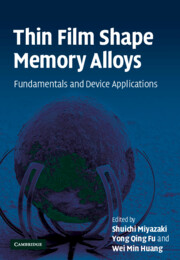Book contents
- Frontmatter
- Contents
- List of contributors
- Preface
- Abstracts of chapters
- 1 Overview of sputter-deposited TiNi based thin films
- 2 Martensitic transformation in TiNi alloys
- 3 Deposition techniques for TiNi thin film
- 4 TiNi multilayer thin films
- 5 Crystallization and microstructural development
- 6 Mechanical properties of TiNi thin films
- 7 Stress and surface morphology evolution
- 8 Ion implantation processing and associated irradiation effects
- 9 Laser post-annealing and theory
- 10 Overview of thin film shape memory alloy applications
- 11 Theory of SMA thin films for microactuators and micropumps
- 12 Binary and ternary alloy film diaphragm microactuators
- 13 TiNi thin film devices
- 14 Shape memory microvalves
- 15 Superelastic thin films and applications for medical devices
- 16 Fabrication and characterization of sputter-deposited TiNi superelastic microtubes
- 17 Thin film shape memory microcage for biological applications
- 18 Shape memory thin film composite microactuators
- 19 TiNi thin film shape memory alloys for optical sensing applications
- Index
11 - Theory of SMA thin films for microactuators and micropumps
Published online by Cambridge University Press: 23 February 2010
- Frontmatter
- Contents
- List of contributors
- Preface
- Abstracts of chapters
- 1 Overview of sputter-deposited TiNi based thin films
- 2 Martensitic transformation in TiNi alloys
- 3 Deposition techniques for TiNi thin film
- 4 TiNi multilayer thin films
- 5 Crystallization and microstructural development
- 6 Mechanical properties of TiNi thin films
- 7 Stress and surface morphology evolution
- 8 Ion implantation processing and associated irradiation effects
- 9 Laser post-annealing and theory
- 10 Overview of thin film shape memory alloy applications
- 11 Theory of SMA thin films for microactuators and micropumps
- 12 Binary and ternary alloy film diaphragm microactuators
- 13 TiNi thin film devices
- 14 Shape memory microvalves
- 15 Superelastic thin films and applications for medical devices
- 16 Fabrication and characterization of sputter-deposited TiNi superelastic microtubes
- 17 Thin film shape memory microcage for biological applications
- 18 Shape memory thin film composite microactuators
- 19 TiNi thin film shape memory alloys for optical sensing applications
- Index
Summary
Abstract
This chapter summarizes several recent theoretical and computational approaches for understanding the behavior of shape memory films from the microstructure to the overall ability for shape recovery. A new framework for visualizing microstructure is presented. Recoverable strains in both single crystal and polycrystalline films are predicted and compared with experiments. Some opportunities for new devices and improvements in existing ones are also pointed out here.
Introduction
The explosive growth of microsystems has created a great need for the development of suitable microactuators and micropumps. Among these applications, micropumps with large pumping volume per cycle and high pumping pressure are essential to microfluidic devices. This requires a large actuation energy density to transmit a high force through a large stroke. However, common MEMS-integrated actuation schemes can deliver limited stroke and actuation force; specifically, the typical output pressure of these pumps is of the order of several tens of kPa. Therefore, there is an important need for finding suitable materials which are able to deliver a high work output from a small volume. Shape memory alloys show great promise in this aspect since they outperform other actuation material in work to volume ratio; consequently, they are able to recover large strain at high force [1, 2, 3, 4]. A disadvantage of using these alloys is that the frequency of operation is relatively low due to limitations on heat transfer. But this can be improved in thin films because of the increase in the surface area to volume ratio. Currently an operation frequency of 100Hz has been demonstrated using the R-phase transformation [5].
- Type
- Chapter
- Information
- Thin Film Shape Memory AlloysFundamentals and Device Applications, pp. 275 - 299Publisher: Cambridge University PressPrint publication year: 2009
- 1
- Cited by



